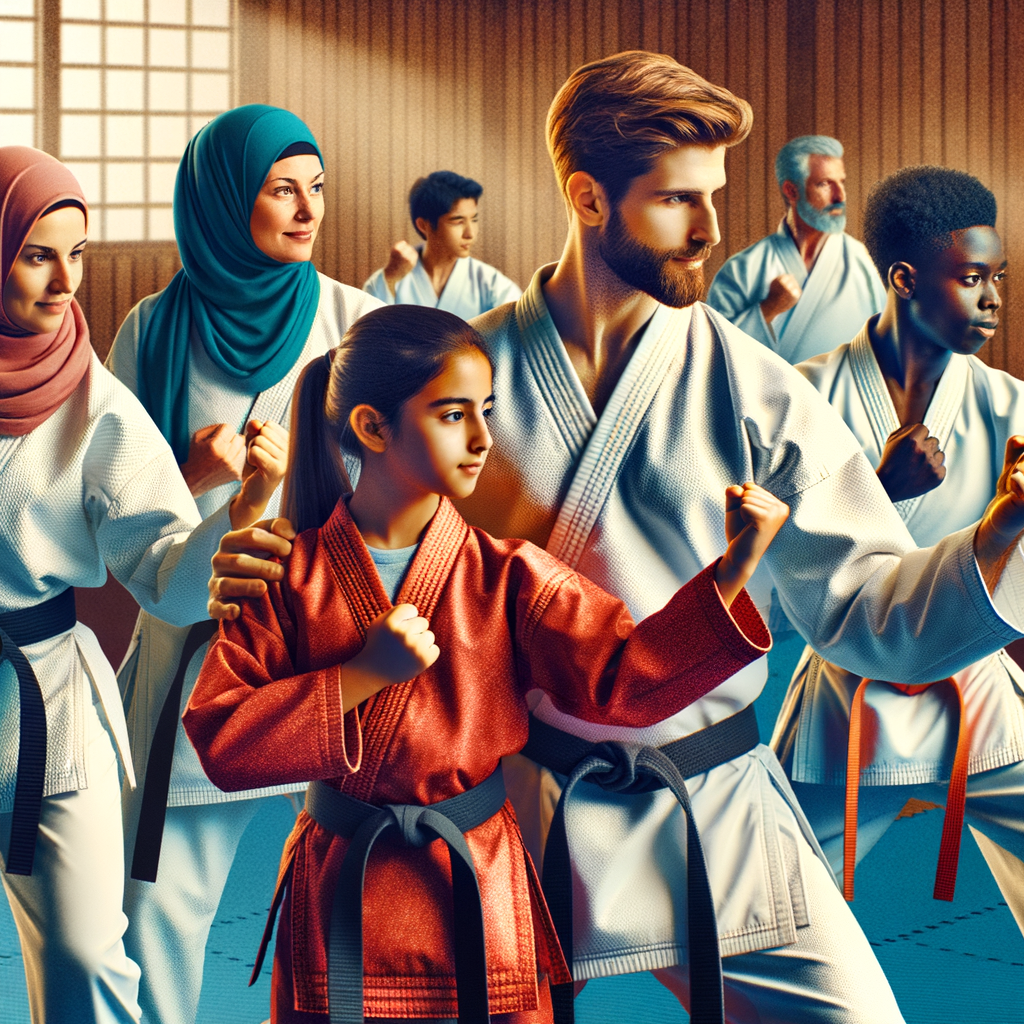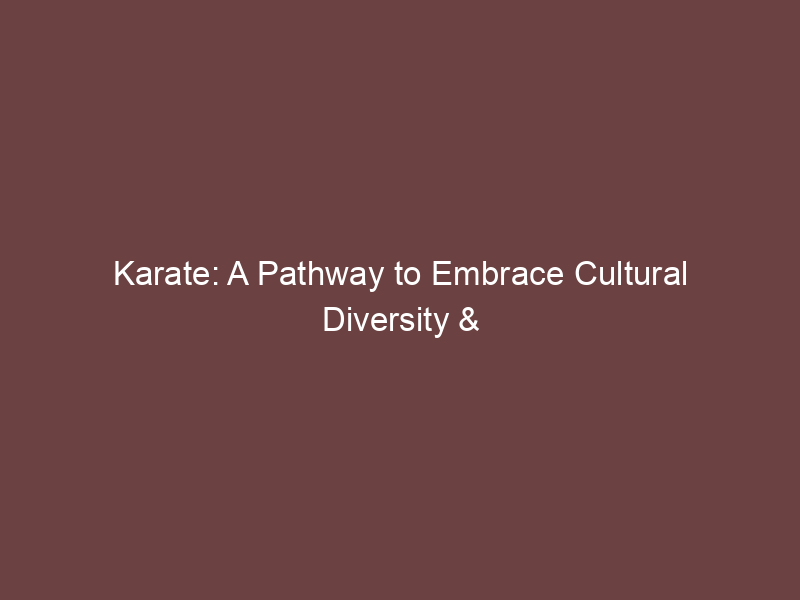
Introduction to Karate and Cultural Diversity
When we think about karate, we often picture the physical aspect of the martial art. However, there’s more to it than meets the eye. Karate is also a melting pot of cultural diversity, a place where people from different backgrounds come together to learn and grow. This article explores the intersection of karate and cultural diversity and the importance of embracing differences in martial arts.
- The Intersection of Karate and Cultural Diversity
- Embracing Differences in Martial Arts
Originating from the Ryukyu Kingdom, now known as Okinawa, Japan, karate has spread across the globe, attracting a diverse range of practitioners. This martial art is not just about self-defense or physical fitness; it’s also about understanding and respecting different cultures. Karate schools worldwide are filled with students of various ages, genders, ethnicities, and cultural backgrounds. This diversity enriches the learning experience, fostering mutual respect and understanding among students.
In karate, differences are not just tolerated; they are celebrated. Each student brings their unique perspective and experiences to the dojo, contributing to a richer and more diverse learning environment. The practice of karate emphasizes respect for all, regardless of their background or differences. This principle is often reflected in the dojo’s etiquette, where students bow to each other as a sign of respect before and after sparring sessions. By embracing these differences, karate promotes a sense of unity and mutual respect among its practitioners.
As we delve deeper into the history of karate and its cultural diversity, we’ll discover how this martial art has evolved over the centuries and how it continues to promote multiculturalism today. Stay tuned for the next sections, where we’ll explore the history of karate, understand cultural diversity in karate, and discuss how we can further embrace differences in this martial art.
The History of Karate
Understanding the history of Karate provides a deeper appreciation for this martial art. Let’s explore its origins and evolution.
Origins and Evolution
From its humble beginnings to the global phenomenon it is today, Karate has a rich and fascinating history.
-
Historical context of Karate
Karate originated from the Ryukyu Kingdom, now known as Okinawa, Japan, during the 17th century. It was a time when weapons were banned by the ruling class, leading the locals to develop a form of self-defense using their bodies. This martial art, initially called “Te” meaning “hand”, was the beginning of what we now know as Karate.
It was not until the 20th century that Karate was introduced to mainland Japan. Gichin Funakoshi, a renowned Karate master, played a significant role in this. He modified the martial art to make it more accessible and appealing to the Japanese, leading to its widespread popularity.
-
The evolution of Karate
Over the years, Karate has evolved significantly. It has branched out into various styles, each with its unique characteristics and techniques. Some of the most popular styles include Shotokan, Goju-Ryu, and Shito-Ryu.
Despite these variations, the core principles of Karate remain the same – respect, discipline, and self-improvement. It’s not just about physical strength; it’s about mental fortitude and character development.
Today, Karate is practiced worldwide and is even included in the Olympic Games, a testament to its enduring appeal and global recognition.
Understanding the history and evolution of Karate helps us appreciate the depth and complexity of this martial art. It’s more than just kicks and punches; it’s a discipline that has stood the test of time, evolving and adapting while staying true to its core principles.
Karate and Cultural Diversity
Karate, a martial art form that originated in Okinawa, Japan, has a rich history of embracing cultural diversity. This has been achieved through the integration of various cultural elements into its practice and philosophy. Let’s delve deeper into how Karate has embraced cultural diversity throughout history and some examples of cultural inclusion in Karate.
- How Karate embraced cultural diversity throughout history
- Examples of cultural inclusion in Karate
Historically, Karate has been a melting pot of different cultures. As it spread from Japan to other parts of the world, it absorbed elements from the cultures it encountered. For instance, when Karate was introduced in China, it incorporated elements of Chinese martial arts. Similarly, when it reached the western world, it adapted to local customs and traditions. This cultural exchange has been a two-way street, with Karate also influencing the cultures it has been a part of.
There are numerous examples of cultural inclusion in Karate. One of the most prominent is the use of the ‘dojo’, a traditional Japanese training hall, in Karate schools around the world. The dojo is not just a physical space but also a symbol of respect and discipline, values that are central to Karate. Another example is the use of Japanese terminology in Karate. Regardless of where it is practiced, Karate uses Japanese terms for techniques, ranks, and commands. This not only preserves the art’s roots but also fosters a sense of global community among practitioners.
In conclusion, Karate’s history and practice are a testament to its embrace of cultural diversity. It is a martial art form that has not only adapted to different cultures but also enriched them. This makes Karate a truly global martial art, one that transcends borders and brings people together.
Understanding Cultural Diversity in Karate
In the world of martial arts, Karate stands out not only for its unique techniques but also for its rich cultural diversity. This diversity is a significant aspect of Karate that contributes to its global appeal and enriches the practice in numerous ways.
Significance of Cultural Diversity in Karate
Understanding the significance of cultural diversity in Karate is crucial for appreciating the depth and richness of this martial art. Let’s delve into the importance of cultural diversity in Karate and how it enriches the practice.
- The importance of cultural diversity in Karate
- How cultural diversity enriches Karate
Cultural diversity plays a pivotal role in Karate. It brings together different perspectives, techniques, and philosophies from around the world, making Karate a truly global martial art. This diversity also promotes inclusivity, allowing people of all backgrounds to participate and learn from each other.
Cultural diversity enriches Karate in several ways. It introduces variety in techniques, making the practice more dynamic and interesting. It also fosters mutual respect and understanding among practitioners from different cultures. Moreover, it encourages innovation and evolution in Karate, as different cultures contribute their unique insights and approaches to the martial art.
In conclusion, cultural diversity is a significant aspect of Karate that enhances its global appeal, fosters mutual respect, and promotes innovation. It is a testament to the universal appeal of this martial art and its ability to bring people together, regardless of their cultural backgrounds.
Examples of Cultural Diversity in Karate
Let’s explore some real-life examples that show how cultural diversity has shaped and enriched the world of Karate.
-
Case study: Karate in different cultures
One of the most compelling examples of cultural diversity in Karate can be seen when comparing the practice of this martial art across different cultures. For instance, in Japan, the birthplace of Karate, the focus is often on discipline, respect, and self-improvement. The training is rigorous and structured, with an emphasis on perfecting form and technique.
On the other hand, in Brazil, Karate is often mixed with local martial arts to create a unique style. The Brazilian style of Karate is more fluid and incorporates elements of dance and acrobatics, reflecting the country’s vibrant culture. This shows how Karate can adapt and evolve to fit into different cultural contexts, making it a truly global martial art.
-
Case study: Multicultural Karate schools
Another example of cultural diversity in Karate can be found in multicultural Karate schools. These schools welcome students from various cultural backgrounds, promoting inclusivity and mutual respect.
One such school is the International Karate Center in New York City. The school boasts students from over 30 different countries, each bringing their unique cultural perspectives to the dojo. The instructors emphasize the importance of understanding and respecting each other’s cultures, fostering a sense of unity among the diverse student body.
Through this multicultural approach, students not only learn Karate but also gain a broader understanding of the world and its diverse cultures. This enriches their Karate experience and helps them grow as individuals.
In conclusion, these case studies highlight the significant role of cultural diversity in Karate. They show how Karate transcends cultural boundaries, adapting to different cultural contexts and promoting inclusivity and respect for diversity. This makes Karate not just a martial art, but also a tool for cultural exchange and understanding.
Embracing Differences in Karate
In the world of Karate, differences are not just accepted, they are celebrated. This martial art form, which originated in Japan, has a rich history of promoting inclusivity and understanding among its practitioners. Let’s delve deeper into how Karate promotes inclusivity and fosters cultural understanding.
How Karate Promotes Inclusivity
One of the most beautiful aspects of Karate is its inclusivity. Regardless of your age, gender, or cultural background, you can participate in Karate. It’s a sport that doesn’t discriminate but rather embraces diversity. Let’s explore the principles of inclusivity in Karate and how it fosters cultural understanding.
- Principles of inclusivity in Karate: In Karate, every individual is treated with respect and dignity. The dojo, or training hall, is a place where everyone is equal. The principles of Karate teach us to respect our opponents and treat them with honor. This respect extends beyond the dojo, promoting a sense of inclusivity and acceptance in all aspects of life.
- How Karate fosters cultural understanding: Karate is practiced worldwide, bringing together people from different cultures and backgrounds. This global reach provides a unique opportunity to learn about and understand different cultures. As you train with people from various cultures, you learn to appreciate their unique traditions and values. This fosters a deep sense of cultural understanding and mutual respect.
In conclusion, Karate is more than just a martial art form. It’s a platform that promotes inclusivity and fosters cultural understanding. By embracing differences, Karate teaches us to respect and value diversity, making it a truly inclusive sport.
Benefits of Embracing Differences in Karate
In the world of Karate, embracing differences is not just about accepting the diversity of cultures, but also about reaping the benefits that come with it. Let’s delve into the two major benefits of embracing differences in Karate.
- Personal growth through understanding different cultures
- Enhanced team dynamics in multicultural Karate schools
When you step into a Karate dojo, you step into a world that is rich with cultural diversity. This exposure to different cultures can be a catalyst for personal growth. As you learn about the traditions, customs, and values of your fellow Karate practitioners from different backgrounds, you gain a broader perspective of the world. This understanding fosters empathy, respect, and open-mindedness, qualities that are not only beneficial in Karate but also in life.
Embracing differences in a multicultural Karate school can significantly enhance team dynamics. When individuals from diverse backgrounds come together, they bring unique skills, experiences, and perspectives to the table. This diversity can foster creativity, innovation, and problem-solving, leading to a more dynamic and effective team. For instance, a Karateka from Japan may approach a technique differently from a Karateka from Brazil, and this diversity of approaches can lead to a richer learning experience for everyone.
In conclusion, embracing differences in Karate can lead to personal growth and enhanced team dynamics. It’s not just about accepting diversity, but also about leveraging it for personal and collective growth. So, the next time you step into a dojo, remember to embrace the differences, for they are the stepping stones to a richer Karate experience.
Diversity in Martial Arts
In the world of martial arts, diversity is not just about different fighting styles. It’s about the rich tapestry of cultures, traditions, and philosophies that each martial art brings to the table. Let’s delve into this fascinating aspect by comparing Karate with other martial arts.
Comparing Karate with Other Martial Arts
When we talk about diversity in martial arts, it’s important to understand how different martial arts embrace cultural diversity and how inclusive they are. We’ll focus on Karate for comparison.
- How other martial arts embrace cultural diversity
- Comparing the inclusivity of Karate with other martial arts
Martial arts like Judo, Taekwondo, and Brazilian Jiu-Jitsu, to name a few, are deeply rooted in their respective cultures. They not only teach self-defense techniques but also impart values, traditions, and customs of their origin countries. For instance, Brazilian Jiu-Jitsu is not just about grappling techniques; it’s also about the Brazilian culture of resilience and determination.
When it comes to inclusivity, Karate stands tall among other martial arts. Originating from Okinawa, Japan, Karate is practiced by millions of people worldwide, irrespective of their age, gender, or physical abilities. This is because Karate emphasizes self-improvement, discipline, and respect over physical prowess. In comparison, some martial arts may require a certain level of physical fitness or flexibility, making them less accessible to some individuals.
In conclusion, while each martial art has its unique cultural nuances and inclusivity levels, Karate stands out for its universal appeal and emphasis on personal growth over physical strength. This makes it a welcoming and diverse martial art that anyone can practice and benefit from.
Lessons from Diversity in Martial Arts
As we delve deeper into the world of martial arts, we can uncover some truly valuable lessons from its inherent diversity. Let’s explore these insights further.
- Key takeaways from the diversity in martial arts
Martial arts, in its many forms, is a global phenomenon that transcends cultural boundaries. This diversity is not just about different styles or techniques, but also about the values and philosophies that each martial art embodies. Here are some key takeaways from this diversity:
| Takeaway | Explanation |
|---|---|
| Respect for different cultures | Each martial art has its roots in a specific culture, teaching us to respect and appreciate these differences. |
| Unity in diversity | Despite the differences, all martial arts share a common goal – self-improvement and self-discipline. |
| Learning from others | Interacting with different martial arts styles allows us to learn and grow, broadening our perspectives. |
- How martial arts promote cultural understanding
Martial arts is not just about physical prowess, but also about understanding and respecting different cultures. Each martial art form, be it Karate, Judo, Taekwondo, or Kung Fu, has its unique cultural heritage and philosophy. By learning these different forms, we are also learning about their respective cultures.
For instance, Karate, which originated in Japan, teaches the values of respect, humility, and discipline, which are deeply rooted in Japanese culture. Similarly, Taekwondo, a Korean martial art, emphasizes the principles of courtesy, integrity, perseverance, self-control, and indomitable spirit, reflecting the values of Korean society.
Thus, martial arts serve as a bridge, promoting cultural understanding and fostering a sense of global unity. As we learn and practice different martial arts, we are not just improving our physical abilities, but also enriching our cultural knowledge and understanding.
Conclusion: Karate and Multiculturalism
As we reach the end of our exploration into the world of Karate and multiculturalism, it’s clear that this martial art is more than just a form of self-defense. It’s a global phenomenon that brings together people from all walks of life, fostering understanding and respect for diverse cultures.
- The future of Karate in a multicultural world
- How Karate continues to embrace cultural diversity
With the world becoming increasingly multicultural, Karate is set to play an even more significant role in promoting cultural diversity. As it continues to spread across the globe, it’s likely that we’ll see even more variations and styles emerge, each one reflecting the unique culture of its origin. This will not only enrich the art of Karate itself, but also contribute to a more inclusive and understanding world.
From its roots in Okinawa, Karate has always been a martial art that embraces cultural diversity. Today, it is practiced in over 190 countries, each with its own unique style and interpretation. This is a testament to Karate’s ability to adapt and evolve, while still maintaining its core principles. By continuing to embrace and celebrate this diversity, Karate can serve as a powerful tool for promoting multicultural understanding and respect.
In conclusion, Karate is more than just a martial art. It’s a global community that brings together people from all walks of life, promoting understanding and respect for cultural diversity. As we look to the future, it’s clear that Karate will continue to play a vital role in promoting multiculturalism and fostering a more inclusive world.
| Key Takeaways |
|---|
| Karate is a global phenomenon that promotes cultural diversity. |
| The future of Karate lies in its ability to adapt and evolve, reflecting the unique cultures of its practitioners. |
| Karate will continue to play a vital role in promoting multicultural understanding and respect. |






